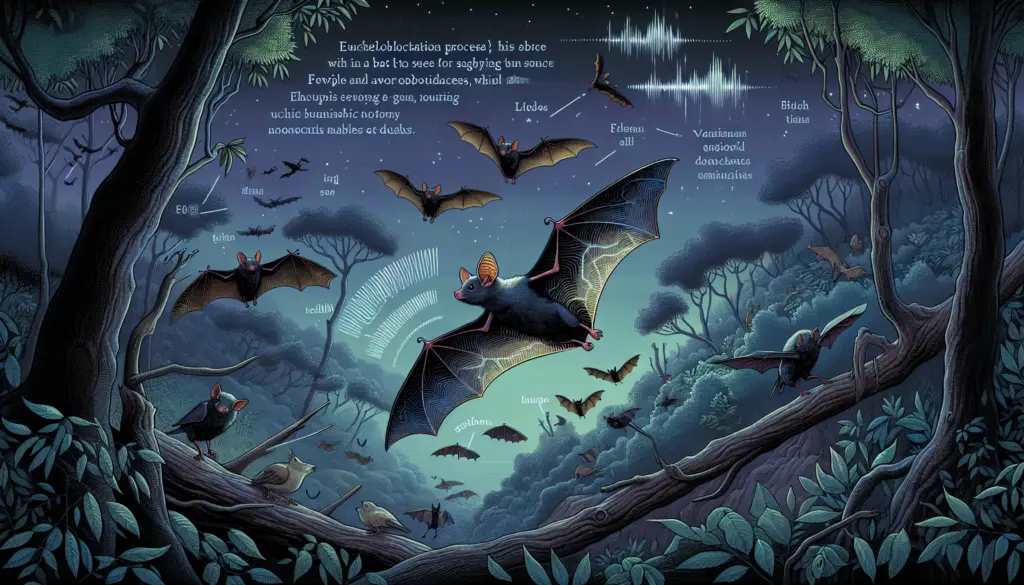How Do Bats See and Avoid Obstacles While Flying?
Table of Contents
ToggleBats navigate the night skies with remarkable precision, deftly avoiding obstacles and catching prey in complete darkness.
The secret behind this incredible ability is echolocation, a biological sonar system that allows bats to “see” with sound.
By emitting high-frequency sounds and listening to the returning echoes, bats create a mental map of their surroundings.
This fascinating adaptation enables them to fly safely, hunt effectively, and thrive in nocturnal environments.
Understanding Echolocation
Echolocation is the process of using sound waves and echoes to determine where objects are in space.
Bats produce ultrasonic sounds—typically beyond the range of human hearing—that bounce off objects and return as echoes.
By interpreting these echoes, bats can gauge the size, shape, distance, and even texture of objects around them.
This allows them to detect everything from tiny insects to large obstacles in their flight path.
The Mechanics of Bat Echolocation
When a bat emits a sound wave, it travels until it hits an object and reflects back.
The time it takes for the echo to return helps the bat calculate the distance to the object.
The frequency and intensity of the echo provide information about the object’s characteristics.
Bats can emit up to 200 pulses per second during rapid pursuit, allowing for real-time updates of their environment.
Anatomical Adaptations for Echolocation
Bats have specialized anatomical features that enhance their echolocation abilities.
Many species possess elaborate nose leaves that help focus their emitted sounds.
Their ears are highly sensitive and often have unique shapes to better capture returning echoes.
Some bats can even move their ears independently to pinpoint the exact location of sounds.
Different Echolocation Calls for Different Situations
Bats adjust their echolocation calls based on their activity and environment.
In open spaces, they use lower frequency calls that travel farther but provide less detail.
In cluttered environments like forests, they switch to higher frequency calls for greater resolution.
Some species can even produce two frequencies at once, a technique known as harmonics, to gather more information.
Avoiding Obstacles Mid-Flight
While flying, bats constantly emit echolocation calls to detect obstacles in their path.
They can detect objects as fine as a human hair, allowing them to maneuver with incredible agility.
By processing the echoes, bats adjust their flight path in real-time to avoid collisions.
This is essential not just for navigation but also for locating roosting spots and avoiding predators.
Hunting Prey Using Echolocation
Bats rely heavily on echolocation to hunt insects and other small prey.
They can detect the faint echoes from a tiny insect’s fluttering wings.
Once they lock onto their target, bats adjust their calls to a higher frequency for precise tracking.
This allows them to intercept swift and unpredictable prey mid-air.
Challenges and Limitations of Echolocation
Echolocation isn’t without its challenges.
In noisy environments, background sounds can interfere with echo detection.
Some insects have evolved to hear bat calls and take evasive action.
Bats overcome these challenges by adapting their call frequency and timing.
Role of Vision and Other Senses
Contrary to popular belief, most bats are not blind and do use their eyesight.
During twilight or when close to light sources, bats may rely more on vision.
They also use their sense of smell and touch to interact with their environment.
However, echolocation remains their primary navigation tool in the dark.
Echolocation in Different Bat Species
Various bat species have unique echolocation adaptations.
For example, the Greater Horseshoe Bat uses long-duration calls suited for detecting distant objects.
The Mexican Free-Tailed Bat emits calls that are effective for high-speed flight.
Understanding these differences helps researchers learn more about bat ecology and behavior.
Bat Detectors: Listening to Echolocation
Bat enthusiasts and researchers often use bat detectors to listen to echolocation calls.
These devices convert ultrasonic bat calls into sounds audible to humans.
They can be a valuable tool for studying bat activity and identifying different species based on their calls.
Using a bat detector can enhance your understanding of these fascinating creatures.
Find This and More on Amazon
Human Technologies Inspired by Bats
Bats have inspired advancements in human technology, particularly in sonar and radar.
Scientists study bat echolocation to improve navigation systems and robotics.
For instance, drones equipped with echolocation-like sensors can navigate complex environments.
These innovations highlight the importance of understanding bat biology.
Echolocation and Conservation Efforts
Conservationists use knowledge of echolocation to monitor bat populations.
Acoustic surveys help track species diversity and abundance.
This information is crucial for protecting bats and their habitats.
Efforts to conserve bats also benefit ecosystems where bats play essential roles.
The Myth of Blind Bats
A common misconception is that bats are blind.
In reality, most bats have good vision, adapted for low-light conditions.
The saying “blind as a bat” doesn’t reflect the true nature of these animals.
Understanding bats helps dispel myths and promotes appreciation for them.
Experiencing Bats Up Close
If you’re interested in observing bats, consider visiting a bat sanctuary or joining a guided tour.
Places like the Congress Avenue Bridge in Austin, Texas, offer opportunities to see large bat colonies.
Remember to respect bats and observe them responsibly to avoid causing disturbances.
Learning about bats firsthand can be a rewarding experience.
Conclusion
Bats navigate and avoid obstacles while flying through the sophisticated use of echolocation.
This remarkable biological system enables them to thrive in the darkness where few other creatures can.
By emitting ultrasonic sounds and interpreting the returning echoes, bats create a detailed sonic map of their environment.
Their adaptations have fascinated scientists and inspired technological innovations.
Understanding how bats see with sound enriches our appreciation for these incredible animals.
For more insights into bat species and behaviors, you might be interested in learning about the Vampire Bats or the tiny Bumblebee Bat.
Exploring these topics can deepen your knowledge of the diverse world of bats.
If you’re curious about other nocturnal creatures, you might wonder why do deer stomp or learn about deer velvet shedding.
Diving into these subjects reveals the fascinating adaptations animals have developed to survive.



